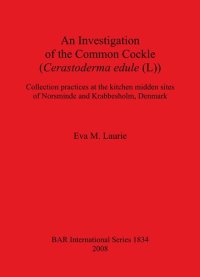
Ebook: An Investigation of the Common Cockle (Cerastoderma edule (L)): Collection practices at the kitchen midden sites of Norsminde and Krabbesholm, Denmark
Author: Eva M. Laurie
- Series: BAR British Archaeological Reports International Series 1834
- Year: 2008
- Publisher: BAR Publishing
- Language: English
- pdf
The aim of this work is to determine to what extent the exploitation of cockles changed across the Mesolithic/Neolithic transition in Denmark. This is an important question for three main reasons: The Mesolithic/Neolithic transition is a key topic in archaeological research; the exploitation of shellfish has been much discussed in terms of environmental and dietary changes over the transition period; wider issues of marine exploitation and human diets have been recently debated for the transition. This research examines these issues through a detailed study of cockles and addresses the following research questions: To what extent did shellfish consumption change through time? What evidence is there for changing cockle exploitation through time? Are there any patterns in the seasonality of cockle exploitation? After the introductory chapter, the first part of chapter 2 briefly explores the relationship between people and sea shells in prehistory and historic times. This is followed by information on the morphology, physiology, habitat and habits of the common cockle. The chapter closes with a review of past mollusc growth line research. Chapters 3 and 4 lays out the methodology followed in the selection and preparation of both the modern and archaeological cockle shells. Chapter 5 introduces background information on the two archaeological sites of Norsminde and Krabbesholm. The archaeological cockle analysis results are presented in chapter 6. Chapter 7 discusses the archaeological results in the context of the questions raised in chapter 1 and chapter 8 draws conclusions and suggests further avenues of research.